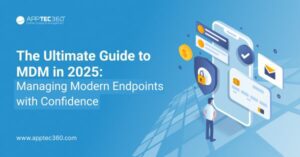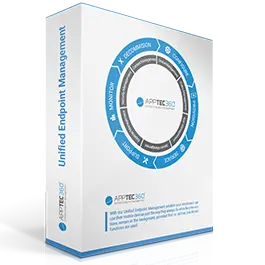Enterprise mobility is no longer just about convenience. Ensuring compliance and security has become absolutely essential. As hybrid work becomes the standard, IT teams are facing pressure to manage a wide range of devices. They must keep control, visibility, and compliance. The demand for cross-platform MDM solutions has grown quickly, whether it involves Android, iOS, macOS, or Windows.
With the rise of BYOD policies, remote onboarding, and changing data protection laws like GDPR and others, companies now need mobile device management tools that offer more than basic control. They require solutions that secure endpoints, support privacy-first frameworks, and scale easily.
But with so many options available, each promising modern features and ease of use, how do you choose the best MDM solution for your business in 2025?
This blog provides a simple comparison of the best MDM solutions in 2025. Whether you want the top MDM for Android, the safest choice for iOS, or an affordable, lightweight platform, you will find useful answers to help you decide with confidence.
Get a free trial of our MDM solution for up to 25 devices and see how easy managing your mobile ecosystem can be.
TL;DR
This blog is for IT leaders, enterprise buyers, and compliance managers looking for a reliable MDM solution for 2025. If you manage a hybrid workforce in Europe or the DACH region, this guide is for you. You’ll find a side-by-side comparison of leading MDM tools, allowing you to confidently choose the one that best suits your enterprise.
What’s Covered:
- Why Mobile Device Management is more critical than ever in 2025
- Key features enterprises should demand from an MDM platform
- Side-by-side comparison of 10 top MDM solutions, including costs, strengths, and considerations
- How to evaluate MDM platforms based on environment, compliance, budget, and scalability
- How AppTec360 aligns well with enterprise needs
What to Look for in an MDM Solution in 2025
Choosing the right mobile device management (MDM) solution in 2025 isn’t just about checking off features. It’s about aligning technology with your company’s changing security, compliance, and productivity needs.
Here’s what IT decision-makers should focus on when looking at cross-platform MDM solutions:
1. Multi-Platform Support (Android, Apple, Windows, macOS)
With mixed device environments becoming the norm, your MDM must handle Android and Apple devices equally well. It should support deep OS integrations and ensure consistent policy enforcement across all endpoints.
2. Privacy-First and GDPR-Compliant Features
In the DACH region, data privacy is essential. Seek tools that provide container-based separation, data encryption, and user privacy controls. These features assist in making sure we comply with GDPR and other local data protection regulations.
3. Seamless Remote Management and Deployment
Zero-touch enrollment, remote configuration, and easy deployment are now essential. These features lower IT workload and help with efficient onboarding for hybrid and remote teams.
4. Advanced Security & Policy Controls
Remote wipe, geofencing, app blacklisting, and real-time threat detection should be standard features. The best MDM for both Apple devices and Android will provide strong protection while keeping things simple.
5. Automation and Real-Time Reporting
Modern MDMs must cut down on manual work by using automated policy enforcement, real-time alerts, and custom reporting dashboards. These features are great for IT audits and quick decision-making.
6. Admin and End-User Experience
Ease of use is important for IT admins who manage large device fleets and for employees on the go. A clean, intuitive dashboard leads to quick adoption and easier daily management.
7. Integration and Scalability
Your MDM must work well with business tools like Microsoft 365, LDAP/MS Active Directory, and Google Workspace. It should also be flexible enough to support your organization’s growth.
Best MDM Solutions Comparison (2025): Which One Fits Your Enterprise?
Enterprises today need clarity. Below is a comparison of top MDM solutions in 2025, covering security, compliance, remote management, and ROI.
MDM Solution
Standout Strengths and Ideal For
Key Considerations and Deployment Model
AppTec360
GDPR-ready containerization, cross‑platform support (Google, Android, Apple iOS, Apple macOS, MS Windows), easy remote deployment, real-time reporting & automation
Ideal For: SMEs to large enterprises in EU/DACH
Affordable, all‑rounder; slightly steeper UI learning curve
Deployement Model: Cloud-hosted or Self-hosted (On-Premises Virtual Appliance)
Microsoft 365
Tight integration with Office 365 & Azure, strong automation and conditional access, robust compliance tools
Ideal For: Microsoft-centric enterprises
Higher cost, steeper learning path
Deployment Model: Cloud-native
VMware Workspace ONE
Extensive security & compliance policies, strong cross-platform UEM, mature automation features
Ideal For: Large corporations with complex needs
High price point and implementation complexity
Deployment Model: Cloud, On-Premises, Hybrid
Jamf Pro
Best-in-class for managing Apple fleets, streamlined updates, privacy-centric features
Ideal For: Apple-focused orgs (education, design, media)
Not suitable for mixed-device setups
Deployment Model: Cloud, On-Premises
IBM MaaS360
AI-driven risk assessment and analytics, strong BYOD features, multi-OS support
Ideal For: Enterprises valuing AI insights & governance
Licensing cost higher; interface less modern
Deployment Model: Cloud
Cisco Meraki MDM
Cloud-native, rapid deployment, visual dashboards, network-device integration
Ideal For: Schools, startups, SMBs
Limited depth in advanced security, compliance
Deployment Model: Cloud-native
Google Workspace Endpoint Management
Native for Google Workspace, lightweight Android & ChromeOS management
Ideal For: G-Suite-centric mid-size firms
Limited Windows/macOS features; not full UEM
Deployment Model: Cloud-native
XenMobile (Citrix Endpoint Management)
Strong app-level security, seamless integration with Citrix VDI
Ideal For: Enterprises using Citrix infrastructure, finance & healthcare sectors
Licensing complexity, best value when bundled with Citrix Workspace
Deployment Model: Cloud & On-prem
Google Workspace Endpoint Management
Native integration with Android & ChromeOS, zero additional cost
Ideal For: Schools, startups, and teams using Google Workspace
Lacks advanced features for iOS and Windows; basic controls
Deployment Model: Cloud
BlackBerry UEM
Military-grade security, broad OS & container support
Ideal For: Highly regulated sectors like government, finance, healthcare
Premium pricing, complex setup for SMBs
Deployment Model: Cloud & On-prem
How to Choose the Right MDM Solution for Your Enterprise
Selecting the right mobile device management platform depends on a few cores’ operational needs. Here’s what enterprises should evaluate before committing:
1. Device Environment
Understand the type and volume of devices your organization manages, whether they are Google, Android, Apple iOS, Apple macOS, MS Windows, or a mix. A solution that works on multiple platforms ensures consistent policy enforcement and control across all endpoints.
2. Compliance and Data Privacy
Enterprises in the EU and DACH regions must prioritize solutions that support GDPR requirements. Look for features such as containerization, data encryption, access logging, and policy-based controls to meet strict compliance rules.
3. Remote Workforce Readiness
If your teams are spread out or use a hybrid model, features such as zero-touch deployment, remote configuration, and remote wipe are necessary. These tools simplify onboarding, cut down on manual tasks, and allow for quicker resolution of security risks.
4. Budget and Cost Structure
Evaluate the licensing model, whether it’s per device, per user, or a flat rate. Consider long-term scalability. Solutions that provide essential features without too many add-ons or hidden costs usually support more sustainable growth, especially for mid-sized teams.
5. Industry-Specific Needs
Some sectors, like education, logistics, and healthcare, may need specific setups, such as kiosk modes, rugged device support, or location tracking. Make sure the solution fits your industry’s operational requirements.
6. Integration and Ecosystem Compatibility
MDM platforms should integrate smoothly with your existing IT systems, whether that includes identity providers like Active Directory, productivity suites, or helpdesk tools. This reduces friction and improves operational continuity.
Every enterprise has unique needs, and there’s no MDM that fits them all. The best choice balances security, usability, and compliance. It should also match your current infrastructure and plans for growth.
Why AppTec360 is a Smart Fit for Modern Enterprises
When evaluating MDM solutions, many organizations in Europe seek a balance between strong features, compliance readiness, and ease of use, without added complexity or high costs.
AppTec360 checks these boxes with a focus on simplicity, scalability, and security. It offers:
- Full cross-platform support across ChromeOS, Android, Apple iOS, Apple macOS, MS Windows
- GDPR-compliant architecture, including containerization and strict policy enforcement
- Real-time automation, remote configuration, and fast deployment features
- A clean user interface optimized for IT teams and enterprise environments
- Transparent pricing with a strong value-to-feature ratio
Final Thoughts
Choosing the right MDM platform is an important decision. It affects not only today’s device management but also long-term data protection, following regulations, and improving operations. By looking at your device environment, workforce structure, and compliance needs, you can find a solution that really fits your business.
If you’re looking for secure, scalable Mobile Device Management software, AppTec’s MDM solution meets modern enterprise needs. It offers a privacy-first, cross-platform approach that complies with EU and global standards. Start your free trial and see it in action.
Get a free trial of our MDM solution for up to 25 devices and see how easy managing your mobile ecosystem can be.
Legal Notice Regarding Trademark Mentions: This analysis has been prepared with due care and to the best of our knowledge, based exclusively on publicly available sources. All brand names, trademarks, and company names mentioned remain the property of their respective owners.



